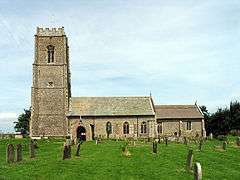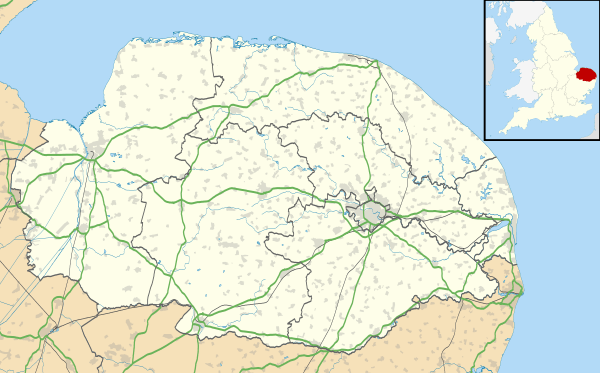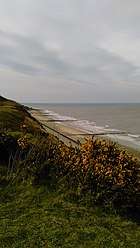Bacton, Norfolk
Bacton is a village and civil parish in Norfolk, England. It is on the Norfolk coast, some 20 kilometres (12 mi) south-east of Cromer, 40 kilometres (25 mi) north-west of Great Yarmouth and 30 kilometres (19 mi) north of Norwich. Besides the village of Bacton, the parish includes the nearby settlements of Bacton Green, Broomholm, Keswick and Pollard Street.[1] It also includes Edingthorpe, which was added to Bacton civil parish under the County of Norfolk Review Order, 1935.
| Bacton | |
|---|---|
 St Andrew's Church, Bacton | |
 Bacton Location within Norfolk | |
| Area | 9.45 km2 (3.65 sq mi) |
| Population | 1,194 (parish, 2011 census) |
| • Density | 126/km2 (330/sq mi) |
| OS grid reference | TG344337 |
| • London | 139 mi (224 km) |
| Civil parish |
|
| District | |
| Shire county | |
| Region | |
| Country | England |
| Sovereign state | United Kingdom |
| Post town | NORWICH |
| Postcode district | NR12 |
| Police | Norfolk |
| Fire | Norfolk |
| Ambulance | East of England |
| UK Parliament | |
The seaside village is located on the North Norfolk coast between Mundesley (a blue flag beach) and Walcott, Norfolk. Bacton is known for its very quiet sandy beaches offering miles of walking along the beach and cliffs. The England Coast Path passes through the village and also the Paston Way long distance footpath linking Cromer and North Walsham.

In the east of the parish can be found the ruined Cluniac Bromholm Priory.[2]
The civil parish has an area of 9.45 square kilometres (3.65 sq mi) and in the 2001 census had a population of 1,130 in 474 households the population increasing to 1,194 at the 2011 Census.[3] For the purposes of local government, the parish falls within the district of North Norfolk.[4]
Amenities in the village include: a village shop, a hotel, two cafes, a Chinese restaurant and kebab house, as well as a recreation ground. In addition there are several caravan parks and estates consisting of privately owned holiday chalets, giving holidaymakers access to the beach. During the First World War there was also an airfield located nearby, RAF Bacton.
Coastal erosion
The village and adjoining coastline has extensive sea defences, erected to prevent coastal erosion. Part of this sea wall in nearby Walcott, Norfolk was damaged in the storm surge in December 2013, which caused damage to several caravans and chalets.
North of Bacton lies the village of Paston where the Bacton Gas Terminal is located. In July 2019 a scheme commenced to deposit almost two million cubic metres of sand, forming a 6-kilometre (4 mi) artificial dune. Costing £20 million, the scheme will protect the gas terminal, as well as the villages of Bacton and Walcott. The sea defences are expected to protect the area for between 15 and 20 years.[5]
References
- Ordnance Survey (2002). "Norfolk Coast East". OS Explorer Map. 252. ISBN 0-319-21888-0.
- "United Kingdom and Ireland Pipelines map - Crude Oil (petroleum) pipelines - Natural Gas pipelines - Products pipelines". Retrieved 14 April 2011.
- "Civil Parish population 2011". Archived from the original on 4 March 2016. Retrieved 1 September 2015.
- "Census population and household counts for unparished urban areas and all parishes". Office for National Statistics & Norfolk County Council. 2001. Archived from the original (XLS) on 11 February 2017. Retrieved 2 December 2005.
- Morelle, Rebecca (18 July 2019). "Vast sand scheme to protect Norfolk coast". BBC News. Retrieved 18 July 2019.
External links

- Information from Genuki Norfolk on Bacton
- Bacton in the Domesday Book
- Village News - local newsletter for Bacton, Edingthorpe, Ridlington and Witton
- Bacton Beach House with photos of the area
- The Leas Beach Park with photos of Bacton beach, fossils found on the beach and the surrounding area